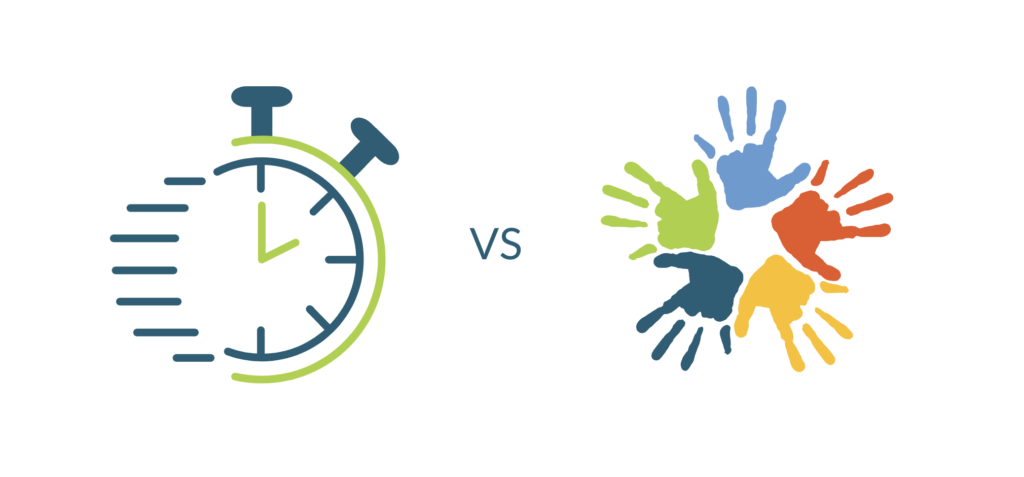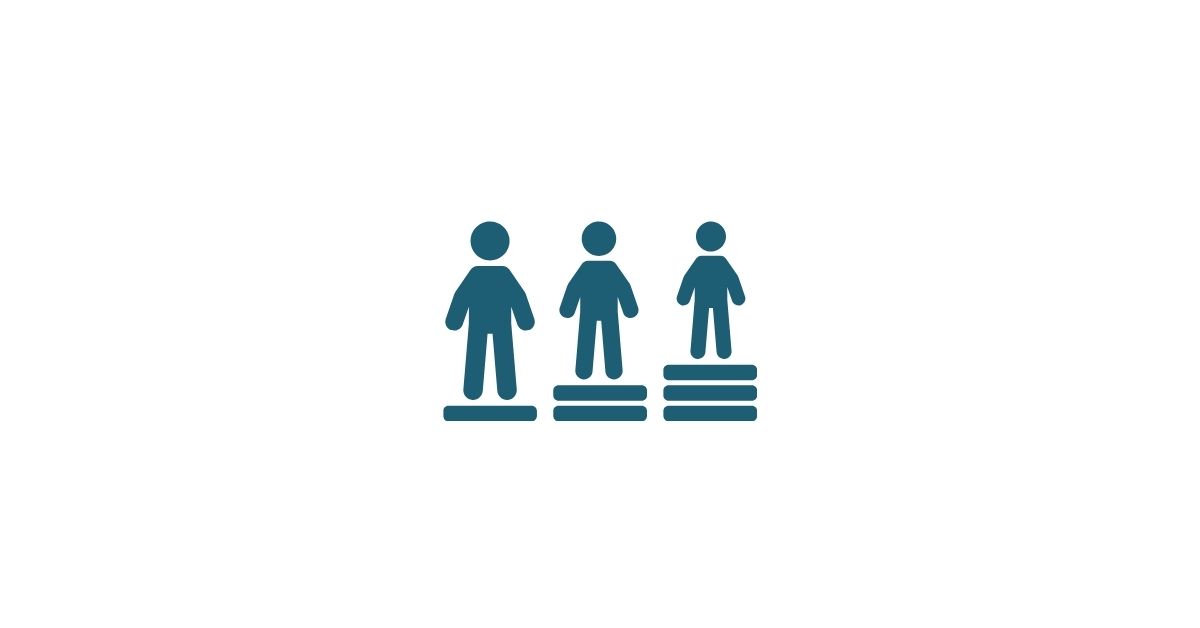Part I: Transitioning from Whole Group to Small Group to Achieve Equity in Education
In the ever-evolving education landscape, one of the most pressing challenges teachers face is striking the right balance between time efficiency and ensuring equitable learning opportunities for all students. As educators embrace innovative technology-enhanced instructional models, they often grapple with letting go of the time-saving practices inherent in the traditional teacher-led, teacher-paced whole group approach to instruction. In this blog series, we’ll explore the delicate balance teachers face when trying to meet the diverse needs of their students while making the most of their limited and valuable instructional time.

The Time-Saving Nature of Traditional Teaching
When I ask educators why so many use the whole group, teacher-led, teacher-paced model predominantly or exclusively, two answers always surface repeatedly: a) it is more time efficient to plan a single lesson for the entire class, and b) it gives teachers control over the content, pace, and classroom management. Both of these perceived benefits are important to acknowledge and explore.
Yes, designing a single experience for the entire class is absolutely easier. I started my career doing this very thing. I would write the day’s learning objectives and agenda on the board and spend each class period moving my students as a unit through a series of learning activities. In terms of design time, it is efficient, and it required less from me cognitively and creatively. However, a one-size-fits-all approach to designing lessons does not result in an equitable learning experience. When every student gets the same experience and teacher time and energy resources, that falls under the umbrella of equality. If we want to strive to provide an equitable experience, we must acknowledge that individual learners will need individual inputs to reach a particular output.
“If we want to create equal opportunities for all learners to suceed, we have to ditch out one-size-fits-all practices and provide flexible pathways for students to learn.”
— Dr. Katie Novak & Dr. Catlin Tucker, UDL and Blended Learning
The Appeal of Maintaining Control
The second reason teachers tend to rely on the whole group lesson is the desire to maintain control. In a whole group teacher-led lesson, we can “cover the content” in our limited time with students. However, it is essential for educators to reflect critically on this approach: Did the students comprehend the subject matter? Will they retain the information? Can they transfer or apply their learning effectively?
While the intent behind controlling the learning environment is often to ensure uniform content delivery, this can inadvertently create a significant equity issue. The emphasis frequently falls on disseminating information and instructing students. As a result, insufficient time is allocated for practical application, review, and personalized support. In the whole group lesson, the teacher’s voice often overshadows the students’ needs, creating a learning environment that fails to address individual learning skills, preferences, or interests.
When teachers devote extensive time to explaining, unpacking, modeling, and guiding, it robs them of the time they need to support and provide feedback as students grapple with complex concepts or apply specific strategies and skills. This disproportionate focus on content transfer impedes students’ ability to practice, review, and apply their learning in an environment where they can receive the necessary support to thrive.
This is especially problematic from an equity perspective because it does not accommodate diverse learning needs, preferences, and paces. If we want to provide a more equitable experience, we must create a learning environment and employ instructional models that are responsive, adaptive, and free the teacher to work alongside individual and small groups of learners. This necessitates a shift from teacher-centered to learner-centered instructional strategies, where students are given the autonomy and support to navigate their learning journeys with confidence.
Honoring Learner Variability and Diverse Student Needs in Our Design
While working with Dr. Katie Novak to write UDL and Blended Learning and The Shift to Student-led with UDL and Blended Learning, we emphasize the fact that learner variability is the norm, not the exception in classrooms. Students are different from each other in terms of how they learn. They bring different skills, abilities, needs, language proficiencies, backgrounds, learning preferences, and interests into the classroom. Yet, the whole group, teacher-led lesson is not flexible enough to honor learner variability or the diversity of needs in classrooms.
“Yet, if there is one takeaway from the burgeoning learning sciences research, it is that no two of us learn in exactly the same way. Each of us go to school with a backpack filled with very different experiences that we draw from to master content, create meaning, work in groups, share our voice, and achieve our potential.”
— Barbara Pape, Learner Variability Is the Rule, Not the Exception
If we want to create more equitable learning experiences, we must know our students and be proactive in identifying potential barriers that might make it challenging for them to acquire information, engage in a learning activity, or navigate a particular task. When working with teachers, I emphasize the importance of providing flexible pathways through a lesson by leveraging technology and prioritizing student agency. For example, some students will acquire information more effectively by reading a text or article, while others will prefer to listen to an audio track or podcast. Some students may thrive self-pacing through a video lesson, while others may be more successful participating in a small group differentiated teacher-led instructional session.
Designing lessons that offer multiple pathways demands a higher level of intentionality and additional time, yet if our goal is to help every student progress toward standard-aligned goals, it is a worthy investment. The result is a learning experience that is more attuned to individual needs and differences, ensuring each student has a fair chance at success.
A well-designed, equitable lesson not only accommodates diverse learning preferences but also minimizes the need for extensive reteaching. This can ultimately save teachers instructional time in the long run. Additionally, if teachers are not trapped at the front of the room orchestrating the parts of a whole group lesson, they can allocate their precious class time to working closely with students on valuable teaching tasks. This includes providing timely and actionable process-based feedback as students work, a practice that not only enhances the students’ learning experience but also reduces the amount of work teachers bring home.
Taking Stock of Current Teaching Practices
I encourage educators to question the prevailing reliance on whole-group, teacher-led instructional design. Is it truly fostering an environment where every student feels supported and successful? Is it accommodating the myriad learning needs, preferences, and paces of a diverse group of students?
The journey towards equitable learning involves moving beyond traditional teaching methods, which often offer uniform experiences to all students, to adopting approaches that allow teachers the flexibility to provide the individualized support each student needs to achieve specific learning goals or outcomes. This transition is not merely pedagogical but is fundamentally rooted in recognizing and respecting the diverse array of learning needs, preferences, and backgrounds in our classrooms. By embracing a more personalized, student-centered approach, we affirm our commitment to valuing and honoring the rich tapestry of learner variability, ensuring that every student is given the opportunity to succeed.
This shift necessitates a critical examination of existing instructional models. A pivotal component of this re-evaluation is acknowledging the critical role of technology, student agency, and small-group instruction in addressing and honoring learner variability. These elements foster a learning environment where individual needs are acknowledged and met, paving the way for more accessible, inclusive, and equitable learning experiences. By questioning the status quo and exploring innovative instructional strategies, teachers can become architects of learning experiences that truly serve all students.
In the next blog post in this series, we’ll explore how teachers can leverage AI to save time architecting equitable, student-centered learning experiences.





No responses yet